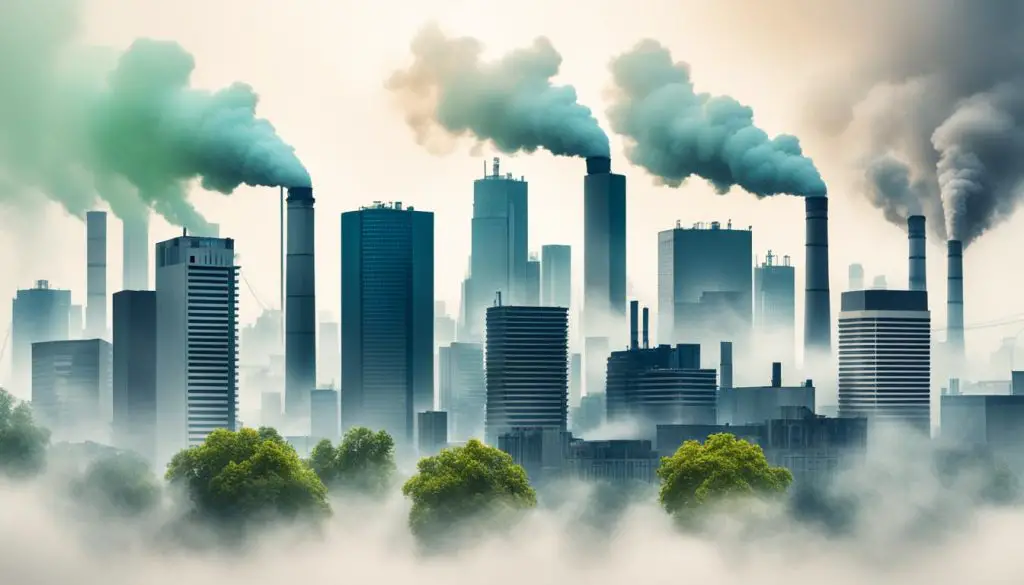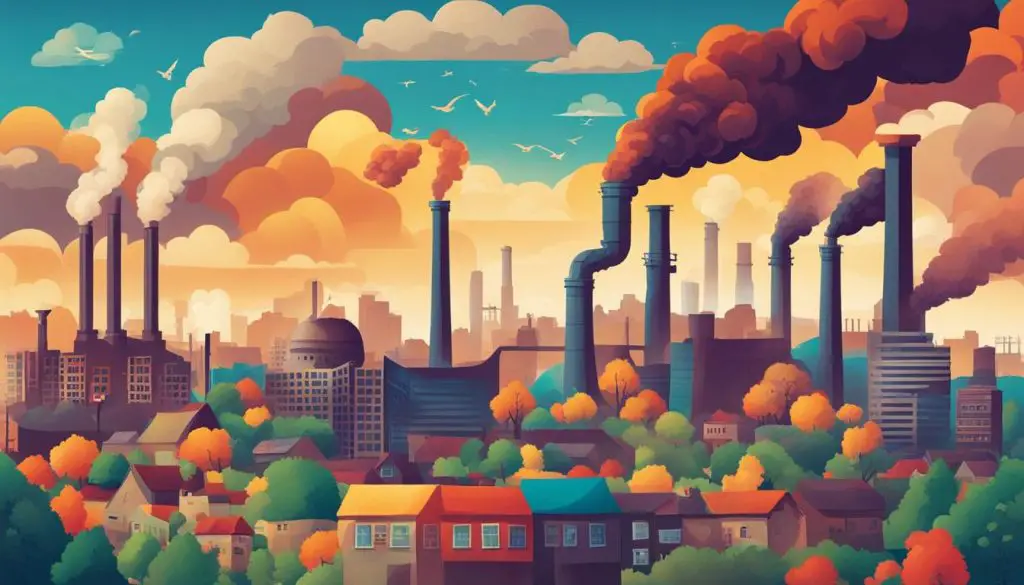
If you’ve ever looked up at a hazy sky and wondered about the quality of the air you’re breathing, you’re not alone. Air pollution, an unfortunate byproduct of modern progress, ranks as one of the most pressing environmental issues of our time. From rural landscapes to bustling cities, the causes of pollution are widespread, igniting concerns over climate change, environmental pollution, and public health.
At the heart of air pollution lies a mix of noxious chemicals and particulates that stem from various anthropogenic activities. Primarily, the burning of fossil fuels for transportation, electricity generation, and industrial use releases a barrage of harmful pollutants. These substances not only impair air quality but also contribute to the broader implications of climate change. Among these pollutants, chlorofluorocarbons (CFCs) pose a unique threat to our ozone layer, with impacts felt on a global scale.
Moreover, the invisible but pernicious effects of pollution, including the relentless encroachment of smog into our atmospheres and the resultant ozone depletion, highlight the need for increased awareness and action. These various types of environmental pollution carry consequences that resonate through our ecosystems and our own well-being. By delving into the nuances of these pollutants, their origins, and their impacts, you empower yourself to become a part of the solution in the ongoing battle against environmental degradation.
Key Takeaways
- Understanding the role of human activity in exacerbating air pollution and climate change is crucial.
- Fossil fuel combustion is a primary source of air pollution, leading to the release of both greenhouse gases and traditional pollutants.
- CFCs, while regulated, still pose a significant threat to the ozone, contributing to its depletion and intensifying climate change.
- Smog, consisting largely of ground-level ozone and particulate matter, has direct adverse effects on human health and the environment.
- Tackling the many types of environmental pollution requires a combined effort of informed individuals, policy changes, and international agreements.
The Dangers of Air Pollution: How CFCs and Smog Affect Our Environment
When considering the wide array of pollutants that contribute to environmental pollution, two culprits often rise to the top: chlorofluorocarbons (CFCs) and smog. These airborne adversaries carry out unseen attacks on the quality of our air, with direct implications for ozone depletion and climate change. As you learn more about the origins and effects of these pollutants, you’ll be better equipped to understand their roles in the greater environmental narrative and how they might be impacting your health and the world around you.
Origins of CFCs and Their Global Impact on the Ozone Layer
Initially celebrated for their stable properties in refrigeration and air conditioning systems, CFCs have since been revealed as one of the key protagonists in the narrative of ozone layer damage. These man-made chemicals find their way into the stratosphere, where they are broken down by ultraviolet light, releasing chlorine atoms that mercilessly attack ozone molecules. This process leads to the degradation of our vital ozone shield, exposing Earth to higher levels of harmful UV radiation and playing a significant role in the conversation on climate change.
Smog Pollution: Causes, Composition, and Health Risks
Unlike the clear danger posed by CFCs, smog presents a murky challenge as it cloaks cities in a dangerous haze. This blend of air pollution, including ground-level ozone and fine particulate matter, is born from the reaction between nitrogen oxides and volatile organic compounds (VOCs) under sunlight. The resultant smog does more than obscure your view—it invades respiratory systems, exacerbating asthma and complicating cardiovascular disease. The environmental impact is also stark, as smog contributes to a warming climate and the complex issues surrounding climate change.
Particulate Matter and Its Role in Air Quality Deterioration
The tiny antagonists known as particulate matter, specifically PM2.5, are often overlooked due to their diminutive size. However, it is precisely their microscopic stature that allows them to penetrate deep into human lungs and even pass into the bloodstream. The consequences of inhaling PM2.5 are severe, with research linking it to respiratory illness, heart disease, and premature death. Tracking the causes of pollution that lead to PM2.5 formation—such as emissions from vehicles and industrial processes—is crucial in battling against air quality deterioration.
Steps the EPA and NASA Are Taking to Monitor and Address Air Pollution
The Environmental Protection Agency (EPA) and NASA are taking decisive action to monitor and mitigate the daunting challenges posed by environmental pollution. Utilizing tools like the Air Quality Index (AQI) and advanced satellite technologies, these organizations are on the front lines, charting the presence of hazardous pollutants and providing critical data that informs policymaking and public awareness. Through diligent monitoring and enforcement of regulations, they aim to improve air quality and safeguard our health and the atmosphere from the ongoing threats of climate change and ozone depletion.
- Environmental Protection Agency: Implementation of the Clean Air Act and enforcement of air quality standards.
- NASA: Monitoring of atmospheric conditions employing Earth-observing satellites to provide data on pollutant concentrations.
Which Type of Pollution Includes CFCs and Smog?

When unpacking the various types of environmental pollution, it is essential to highlight the pervasive presence of air pollution in our daily lives. This form of pollution, characterized by its insidious and omnipresent nature, includes harmful substances such as chlorofluorocarbons (CFCs) and smog, both of which significantly degrade air quality and contribute to broader environmental concerns.
Environmental pollution impacts more than just the natural world; it reaches into the very air that you breathe. CFCs, once commonplace in refrigerants and aerosols, now persist as pollutants with long-lasting effects on the ozone layer. Although international efforts have significantly curtailed their production, CFCs previously emitted remain active in the atmosphere, depleting the ozone and contributing to climate change.
Smog, often visible as a thick haze over urban landscapes, poses immediate health risks and compromises environmental integrity. Made up of a complex blend of pollutants including particulates and ground-level ozone, smog is a byproduct of industrial emissions and vehicular exhaust. These pollution types not only obscure visibility but also exacerbate respiratory conditions and contribute to the greenhouse effect, amplifying the process of global warming.
Your understanding of types of environmental pollution is incomplete without considering the grave implications of CFCs and smog. It’s not simply a matter of unsightly haze, but a significant environmental issue with profound consequences for public health and the planet’s ecosystems.
- Awareness of the sources of CFCs and their ozone-depleting actions is critical.
- Recognition of smog composition helps identify its origination and formulate mitigation strategies.
- Understanding the health risks related to smog-influenced air brings the issue closer to home.
To truly address environmental pollution, targeted action against both visible and invisible air pollutants is necessary. By identifying and understanding the sources and effects of pollutants like CFCs and smog, you’re taking an essential step toward environmental stewardship and protection of public health.
Strategies to Combat Environmental Pollution and Climate Change
As we grapple with the reality of climate change and its profound effects of pollution, it’s evident that actionable strategies are essential. Both international agreements and personal actions play pivotal roles in mitigating the impact of pollution. Your involvement, combined with global efforts, is crucial in fostering a sustainable future that prioritizes clean air and a healthy environment.
Global Agreements and Protocols: The Montreal Protocol’s Legacy
International efforts, such as the Montreal Protocol, have shown that worldwide cooperation can lead to meaningful change. This landmark protocol, specifically targeting substances that deplete the ozone layer like CFCs, has successfully curtailed emissions that contribute to ozone depletion and environmental pollution. It serves as a testament to the power of collective international policy in combating global environmental issues.
Renewable Energy and Emissions Reduction: A Path to Cleaner Air
Renewable energy is the beacon of hope in the quest for cleaner air and a stable climate. Shifting from fossil fuels to wind, solar, and hydroelectric power sources cuts emissions and reduces our carbon footprint. Advancements in energy efficiency further amplify this effect, demonstrating that the path to mitigating air pollution is through innovation and the adoption of clean energy solutions.
Indoor vs. Outdoor Pollution: Best Practices for Healthier Living Environments
Your home should be a sanctuary, yet indoor pollutants can be just as dangerous as those found outside. Products emitting formaldehyde, VOCs, and other hazardous substances significantly degrade indoor air quality. By opting for low-emission products, ensuring good ventilation, and monitoring for gases like carbon monoxide, you can protect your health and that of your loved ones, creating a safer living environment.
Public Policy and Individual Actions: How You Can Make a Difference
Public policy shapes the clean air landscape by enforcing regulations and standards that promote environmental health. However, your individual actions are equally impactful. By reducing energy consumption, utilizing eco-friendly transportation, and being conscientious about disposing of pollutants, you play an active role in improving air quality and advocating for public policies that prioritize the environment.
FAQ
Q: What are chlorofluorocarbons (CFCs), and why are they harmful?
A: Chlorofluorocarbons (CFCs) are man-made chemicals once widely used in refrigerants, aerosol sprays, and various industrial applications. They are harmful because, when released into the atmosphere and broken down by ultraviolet (UV) radiation, they release chlorine atoms that deplete the ozone layer. This depletion contributes to increased UV radiation reaching the Earth’s surface, which can lead to skin cancer, cataracts, and adverse environmental effects. Additionally, CFCs are potent greenhouse gases contributing to climate change.
Q: What is smog, and how does it form?
A: Smog is a form of air pollution that is a mixture of pollutants, primarily ground-level ozone and particulate matter, which can be hazardous to human health. It forms when pollutants emitted by cars, factories, and other sources react chemically in the presence of sunlight. The term “smog” originally referred to a mixture of smoke and fog, but now describes the photochemical mixture that causes the hazy air quality in many urban areas.
Q: What are some common causes of air pollution?
A: Common causes of air pollution include the burning of fossil fuels such as coal, oil, and natural gas, especially in power plants and vehicles; industrial processes; agricultural activities; burning of waste; and the use of volatile organic compounds (VOCs) in products like paints and solvents. These activities release a variety of pollutants like nitrogen oxides (NOx), sulfur dioxide (SO2), particulate matter, and volatile organic compounds into the air, which can be harmful to health and the environment.
Q: How do CFCs contribute to climate change?
A: CFCs contribute to climate change as they are greenhouse gases with a high global warming potential (GWP). This means they are very effective at trapping heat in the atmosphere, contributing significantly to the greenhouse effect. Although CFCs are present in the atmosphere in much lower concentrations than carbon dioxide, their effect on climate change is disproportionately high due to their GWP.
Q: What are the health risks associated with smog?
A: Smog can cause a range of health issues, particularly for the elderly, children, and those with pre-existing respiratory problems like asthma. Health risks include irritation of the eyes, nose, and throat, shortness of breath, aggravated asthma, and an increased risk of respiratory infections. Long-term exposure can lead to more serious conditions such as chronic bronchitis and decreased lung function.
Q: What is the Air Quality Index (AQI), and how is it used?
A: The Air Quality Index (AQI) is a tool used by the Environmental Protection Agency (EPA) and other agencies to communicate how polluted the air currently is or how polluted it is forecast to become. The AQI measures the concentration of pollutants in the air, such as ozone, particulate matter, carbon monoxide, sulfur dioxide, and nitrogen dioxide, on a scale from 0 to 500. Lower values indicate good air quality, while higher values indicate poorer air quality and increased potential for adverse health effects.
Q: What was the Montreal Protocol, and what has it achieved?
A: The Montreal Protocol is an international treaty designed to phase out the production and consumption of ozone-depleting substances (ODS), including CFCs. Signed in 1987, it has been successful in reducing the emissions of ODS, leading to a gradual recovery of the ozone layer. It’s considered one of the most successful environmental agreements to date and has been ratified by almost every country in the world.
Q: How can I reduce my personal contribution to air pollution?
A: You can reduce your personal contribution to air pollution by engaging in several practices: using public transportation, cycling, or walking instead of driving; saving energy at home by using energy-efficient appliances and lighting; reducing, reusing, and recycling materials; choosing products with fewer VOCs; and supporting clean energy initiatives and policies that aim to reduce industrial emissions. Every small change can make a collective difference in improving air quality.
Q: Are there differences between indoor and outdoor pollution?
A: Yes, there are differences between indoor and outdoor pollution. Outdoor pollution commonly includes pollutants like smog, ozone, and particulate matter from various sources including traffic and industrial emissions. Indoor pollution involves pollutants that originate inside buildings from sources like tobacco smoke, cooking, off-gassing from building materials and furnishings, and household cleaning products. Both types of pollution can be harmful to health and require different strategies to manage and minimize exposure.


























